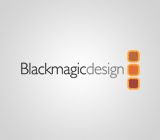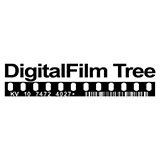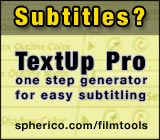|
|
Forum List
>
Café LA
>
Topic
OT production HD Q
Posted by smyth
|
OT production HD Q February 26, 2010 05:41AM |
Registered: 18 years ago Posts: 38 |
Hi,
I am going to be producing a children's show for DVD and maybe web distribution.
I own a sony z1. don't have experience with shooting and editing HD. I've been producing non-profits for some time. I'm working over seas and still working in standard dv.
this show will be for the states and should be in HD. now to the question.
I was looking to buy the canon HF s10 (after hearing great things on LAFCPUG)
Will there be a challenge mixing the different resolutions of HD between the canon and sony?
Any advice is greatly appreciated.
Thanks
Mitch
I am going to be producing a children's show for DVD and maybe web distribution.
I own a sony z1. don't have experience with shooting and editing HD. I've been producing non-profits for some time. I'm working over seas and still working in standard dv.
this show will be for the states and should be in HD. now to the question.
I was looking to buy the canon HF s10 (after hearing great things on LAFCPUG)
Will there be a challenge mixing the different resolutions of HD between the canon and sony?
Any advice is greatly appreciated.
Thanks
Mitch
|
Re: OT production HD Q February 26, 2010 05:57AM |
Moderator Registered: 18 years ago Posts: 10,771 |
> Will there be a challenge mixing the different resolutions of HD between the canon and sony?
Yes. I own the HF S10, and I really don't like it very much as a video camera. Especially when it comes to motion. It doesn't have a proper 24p mode (its a crappy simulation on the HF S10), and I'm not impressed by its lens. Compared with my GL2 DV camera, colours look a lot less impressive, the controls (especially the focus dial) are fiddly and poorly designed, it's too light, and I don't think it has enough manual features for professional use. The worst part is, the HF S10 dispensed with a viewfinder, making it a lot more awkward to use under bright sunlight. I bought a Hoodman for it and it didn't help, and the Hoodman jutted against the controls on the flip-out LCD screen.
I shot a 10-minute performance of a song at Hermosa Beach with the HF S10, and the camera inexplicably split the files up even though I had a completely empty internal drive and empty SD card to shoot onto, and I'm sure it skipped at least a frame when I tried to join the files back together. That's a deal killer for me as far as professional use. The GL2 was a far superior camera. The HF S10 takes very good stills, though, in my opinion.
And yes, I would suspect noticeable differences mixing Canon and Sony's low-end HD footage. But if you're not sure, test.

www.derekmok.com
Yes. I own the HF S10, and I really don't like it very much as a video camera. Especially when it comes to motion. It doesn't have a proper 24p mode (its a crappy simulation on the HF S10), and I'm not impressed by its lens. Compared with my GL2 DV camera, colours look a lot less impressive, the controls (especially the focus dial) are fiddly and poorly designed, it's too light, and I don't think it has enough manual features for professional use. The worst part is, the HF S10 dispensed with a viewfinder, making it a lot more awkward to use under bright sunlight. I bought a Hoodman for it and it didn't help, and the Hoodman jutted against the controls on the flip-out LCD screen.
I shot a 10-minute performance of a song at Hermosa Beach with the HF S10, and the camera inexplicably split the files up even though I had a completely empty internal drive and empty SD card to shoot onto, and I'm sure it skipped at least a frame when I tried to join the files back together. That's a deal killer for me as far as professional use. The GL2 was a far superior camera. The HF S10 takes very good stills, though, in my opinion.
And yes, I would suspect noticeable differences mixing Canon and Sony's low-end HD footage. But if you're not sure, test.

www.derekmok.com
|
Re: OT production HD Q February 26, 2010 12:05PM |
Moderator Registered: 17 years ago Posts: 8,836 |
|
Re: OT production HD Q February 26, 2010 12:39PM |
Moderator Registered: 16 years ago Posts: 3,410 |
The first question you're going to have to answer is whether you're ever going to go out at 1080. You said DVD, which obviously is standard-definition, and you said web, which these days still rarely means anything over 720. But if you ever hope to go out in 1080, ever, you should plan for it now.
(Hint: Just assume you're working in 1080. It's always better to stick with convention and change your format at the very end than to cut corners up front and regret it later.)
The problem with the Z1U is that it doesn't shoot 24, and 24 is really where you want to be. It's the best frame rate for Internet delivery, simply because it's the lowest frame rate. Fewer frames means less data, which means you get better quality at the same data rate when compressing. So 24 is where you want to be when you do this project.
You say you're new to shooting HD; do you have experience shooting film? Shooting HD is more like shooting film that it is like shooting video. The frame rate is the same, obviously, which means your shutter angle is the same, which means you can think of lighting for HD like lighting-for-film-but. In other words, start by treating the project like it's on film, then adjust your expectations to match your camera of choice.
Frankly, I think you should try out the various DSLRs that are on the market now. You will definitely want to avoid the 5D because the 24p firmware update isn't available yet. (I've heard early-summer.) But that's okay, because if you're only accustomed to shooting 1/3", the jump all the way to a Vistavision (or "full-frame 35mm" in stills-photography lingo) sensor will eat your lunch; it'll be much harder to pull focus if you're not used to such a large image size and correspondingly shallow depth-of-field. A Vistavision image is great for a lot of reasons, but it's really one of those things that you'll positively hate until you learn to work with and love it.
I think the first place you should look is the Canon 7D. It's got an APS-C-sized sensor, which is very close to the standard Super 35 size. That means it's easier to work with than a Vistavision, but still capable of producing far better images than a crappy little consumer 1/3" sensor. Ugh.
Of course, you'll have the issue of glass to deal with. Last I heard, Panavision and Canon were still on the outs legally, so you can't rent the PV-to-Canon lens adapter right now. You almost certainly don't care about that, but it's something to be aware of. You have to do math to figure out focal-length equivalences of stills lenses on an APS-C camera, but it's not that bad: The factor is 1.6 between Vistavision (again, "full frame" in stills parlance) and APS-C, so a 24mm becomes a 38, a 50 becomes an 80, and so on. Because the sensor is small for a stills camera (even though it's totally standard for a motion picture camera) you're going to struggle to find wide-angle lenses. I think there's a 14mm lens out there you could get (it'll act like a 22mm on the 7D), but it costs two or three thousand bucks. Instead, you might ought to look at a zoom lens, like say a 16-35mm f/2.8. Zoom lenses are inherently less well-made than primes, and they're harder to work with because you have to keep your hands well away from the zoom ring, but try it out. It might be a good compromise to keep you on budget.
Workflow-wise, it's obviously harder to work with H.264 stuff off a 7D than, say, DVCPRO HD stuff off a P2 card. You'll have to batch-convert your rushes to ProRes in order to get a seamless workflow. While Final Cut technically can take H.264 stuff right onto the timeline, among other things it can't show you that timeline on your broadcast monitor when you play back. So get ready to set up lots of Compressor jobs.
The good news is that because you aren't changing frame rates at all, you don't have any audio sync issues to worry about. Just set your sound recorder to 23.976 at 48, and you'll be fine. (Obviously you have to shoot dual-system sound when you use a DSLR, but really, you're going to be shooting dual-system sound anyway. There's absolutely zero chance anybody would ever consider trying to use the on-board mic on a consumer camera for anything but home movies.)
The bottom line is that if you're inexperienced shooting HD, you're going to want to practice. A lot. You're going to want to set aside a day to rate your camera, then just shoot the hell out of everything you see. Learn how to protect for highlights while maximizing dynamic range, learn where there noise level becomes unacceptable, that kind of thing. Learn how to move the camera so you minimize rolling shutter issues (because rolling shutter artifacting is a function of the read time of the sensor, and every sensor's different, you just have to try it and find out).
But no, don't buy a home-movie camera to shoot a TV show. It'll never work, and you'll regret it deeply.

(Hint: Just assume you're working in 1080. It's always better to stick with convention and change your format at the very end than to cut corners up front and regret it later.)
The problem with the Z1U is that it doesn't shoot 24, and 24 is really where you want to be. It's the best frame rate for Internet delivery, simply because it's the lowest frame rate. Fewer frames means less data, which means you get better quality at the same data rate when compressing. So 24 is where you want to be when you do this project.
You say you're new to shooting HD; do you have experience shooting film? Shooting HD is more like shooting film that it is like shooting video. The frame rate is the same, obviously, which means your shutter angle is the same, which means you can think of lighting for HD like lighting-for-film-but. In other words, start by treating the project like it's on film, then adjust your expectations to match your camera of choice.
Frankly, I think you should try out the various DSLRs that are on the market now. You will definitely want to avoid the 5D because the 24p firmware update isn't available yet. (I've heard early-summer.) But that's okay, because if you're only accustomed to shooting 1/3", the jump all the way to a Vistavision (or "full-frame 35mm" in stills-photography lingo) sensor will eat your lunch; it'll be much harder to pull focus if you're not used to such a large image size and correspondingly shallow depth-of-field. A Vistavision image is great for a lot of reasons, but it's really one of those things that you'll positively hate until you learn to work with and love it.
I think the first place you should look is the Canon 7D. It's got an APS-C-sized sensor, which is very close to the standard Super 35 size. That means it's easier to work with than a Vistavision, but still capable of producing far better images than a crappy little consumer 1/3" sensor. Ugh.
Of course, you'll have the issue of glass to deal with. Last I heard, Panavision and Canon were still on the outs legally, so you can't rent the PV-to-Canon lens adapter right now. You almost certainly don't care about that, but it's something to be aware of. You have to do math to figure out focal-length equivalences of stills lenses on an APS-C camera, but it's not that bad: The factor is 1.6 between Vistavision (again, "full frame" in stills parlance) and APS-C, so a 24mm becomes a 38, a 50 becomes an 80, and so on. Because the sensor is small for a stills camera (even though it's totally standard for a motion picture camera) you're going to struggle to find wide-angle lenses. I think there's a 14mm lens out there you could get (it'll act like a 22mm on the 7D), but it costs two or three thousand bucks. Instead, you might ought to look at a zoom lens, like say a 16-35mm f/2.8. Zoom lenses are inherently less well-made than primes, and they're harder to work with because you have to keep your hands well away from the zoom ring, but try it out. It might be a good compromise to keep you on budget.
Workflow-wise, it's obviously harder to work with H.264 stuff off a 7D than, say, DVCPRO HD stuff off a P2 card. You'll have to batch-convert your rushes to ProRes in order to get a seamless workflow. While Final Cut technically can take H.264 stuff right onto the timeline, among other things it can't show you that timeline on your broadcast monitor when you play back. So get ready to set up lots of Compressor jobs.
The good news is that because you aren't changing frame rates at all, you don't have any audio sync issues to worry about. Just set your sound recorder to 23.976 at 48, and you'll be fine. (Obviously you have to shoot dual-system sound when you use a DSLR, but really, you're going to be shooting dual-system sound anyway. There's absolutely zero chance anybody would ever consider trying to use the on-board mic on a consumer camera for anything but home movies.)
The bottom line is that if you're inexperienced shooting HD, you're going to want to practice. A lot. You're going to want to set aside a day to rate your camera, then just shoot the hell out of everything you see. Learn how to protect for highlights while maximizing dynamic range, learn where there noise level becomes unacceptable, that kind of thing. Learn how to move the camera so you minimize rolling shutter issues (because rolling shutter artifacting is a function of the read time of the sensor, and every sensor's different, you just have to try it and find out).
But no, don't buy a home-movie camera to shoot a TV show. It'll never work, and you'll regret it deeply.

|
Re: OT production HD Q February 26, 2010 12:55PM |
Moderator Registered: 18 years ago Posts: 6,730 |
I looooooove my HFS 10...for shooting my sons playing football & baseball, Christmas morning, cats playing, etc. I will totally disagree with Derek on his list of shortcomings. The camera has been nothing but a great experience for me...but that said...I would NEVER buy a consumer camera to shoot a TV show for broadcast, performances, client pieces. That's just not smart.
The new rage is DSLR. The footage looks just like film and you can sweeten it in post to look really juicy. Look at the Canon 7D. I am. It's the next big wave in filmmaking.
When life gives you dilemmas...make dilemmanade.

The new rage is DSLR. The footage looks just like film and you can sweeten it in post to look really juicy. Look at the Canon 7D. I am. It's the next big wave in filmmaking.
When life gives you dilemmas...make dilemmanade.

|
Re: OT production HD Q February 26, 2010 08:06PM |
Moderator Registered: 16 years ago Posts: 3,410 |
If you decide you want to know more about DSLRs in general, look up Shane Hurlbut's blog. Whatever you think about the guy personally or his body of work, he's got some very interesting things to say about DSLR cinematography, and he speaks from personal experience. I think it's hurlbutvisual.com or hurlbutvisuals.com, one of those.
One of the things he's advocated for, and this really surprised me, was shooting a DSLR like you're shooting reversal film instead of neg. DSLRs, of course, conspicuously do not output a raw format when you're shooting motion; they all output 8-bit compressed Quicktimes. Which naturally means you have zero latitude in post for grading or color correction. Shane lights as if he's shooting reversal film, which is also notoriously unforgiving, and takes great care to tune the camera just so before rolling on take one. The upside is that he gets pictures he's happy with right out of the camera. The downside, of course, is that if what comes out isn't what he's happy with, there's no saving it. You can only push 8-bit compressed footage very slightly before it breaks up and becomes unusable, so you better either get it on the day or learn to live with it if you don't.
Of course, Shane's also got some other ideas that I'm still skeptical of. For instance, he says he refuses to shoot 24 on digital. He shoots 30, then uses Twixtor to convert it to 24. I heard him say in an interview once that Twixtor's natural softening and blurring (which is normally considered a bad thing) gives him a look he actually prefers, and he just accepts the inevitable artifacts as part of the trade-off of shooting digital. I don't buy that myself, but one of us is a well known professional cinematographer and the other ? um ? isn't, so I'm keeping an open mind.
(Be aware, though, that Shane's even more opinionated than I am, if you can believe it. If that turns you off, maybe he's not a good person to look to for information on DSLR cinematography.)

One of the things he's advocated for, and this really surprised me, was shooting a DSLR like you're shooting reversal film instead of neg. DSLRs, of course, conspicuously do not output a raw format when you're shooting motion; they all output 8-bit compressed Quicktimes. Which naturally means you have zero latitude in post for grading or color correction. Shane lights as if he's shooting reversal film, which is also notoriously unforgiving, and takes great care to tune the camera just so before rolling on take one. The upside is that he gets pictures he's happy with right out of the camera. The downside, of course, is that if what comes out isn't what he's happy with, there's no saving it. You can only push 8-bit compressed footage very slightly before it breaks up and becomes unusable, so you better either get it on the day or learn to live with it if you don't.
Of course, Shane's also got some other ideas that I'm still skeptical of. For instance, he says he refuses to shoot 24 on digital. He shoots 30, then uses Twixtor to convert it to 24. I heard him say in an interview once that Twixtor's natural softening and blurring (which is normally considered a bad thing) gives him a look he actually prefers, and he just accepts the inevitable artifacts as part of the trade-off of shooting digital. I don't buy that myself, but one of us is a well known professional cinematographer and the other ? um ? isn't, so I'm keeping an open mind.
(Be aware, though, that Shane's even more opinionated than I am, if you can believe it. If that turns you off, maybe he's not a good person to look to for information on DSLR cinematography.)

Sorry, only registered users may post in this forum.



 All the news now and in your digital future
All the news now and in your digital future
